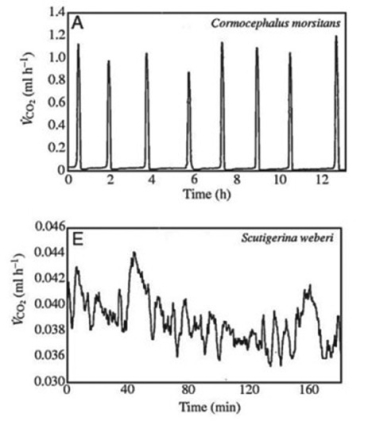Multiple Choice
Many terrestrial arthropods exchange gases with their environments by using tracheae, tubes that lead from openings (called spiracles) in the animal's exoskeleton or cuticle directly to the animal's tissues. Some arthropods can control whether their spiracles are opened or closed; opening the spiracles allows the carbon dioxide produced in the tissues to travel down the tracheae and be released outside the animal. Klok et al. measured the carbon dioxide emitted over time (represented by VCO₂) by several species of centipedes. The figures present graphs of their results for two species, Cormocephalus morsitans and Scutigerina weberi. (C. J. Klok, R. D. Mercer, and S. L. Chown. 2002. Discontinuous gas-exchange in centipedes and its convergent evolution in tracheated arthropods. Journal of Experimental Biology 205:1019-29.) Copyright 2002 The Company of Biologists and the Journal of Experimental Biology. 
Look at the graph for Scutigerina weberi (note the scale of the y-axis) in the figure.
-How would a terrestrial centipede most likely benefit from the ability to close its spiracles? Closing spiracles would ________.
A) allow the centipede to move more quickly
B) allow the centipede to retain more moisture in its tissues
C) allow the centipede to stay warmer
D) allow more oxygen from the environment to reach the centipede's tissues
Correct Answer:

Verified
Correct Answer:
Verified
Q8: Compared to insects with incomplete metamorphosis, insects
Q15: Whiteflies are common pest insects found on
Q16: A primary school science teacher decided to
Q17: The nontaxonomic term sea slug encompasses a
Q19: The crown-of-thorns sea star, Acanthaster planci, preys
Q19: The sea slug Pteraeolidia ianthina can harbour
Q20: Large animals need specialised organs for gas
Q56: What would be the most direct effect
Q73: Parasitism is one of the most widespread
Q81: A terrestrial animal species is discovered with